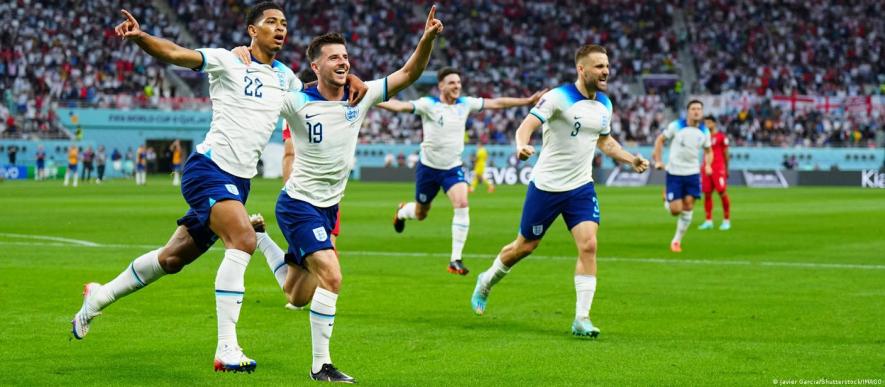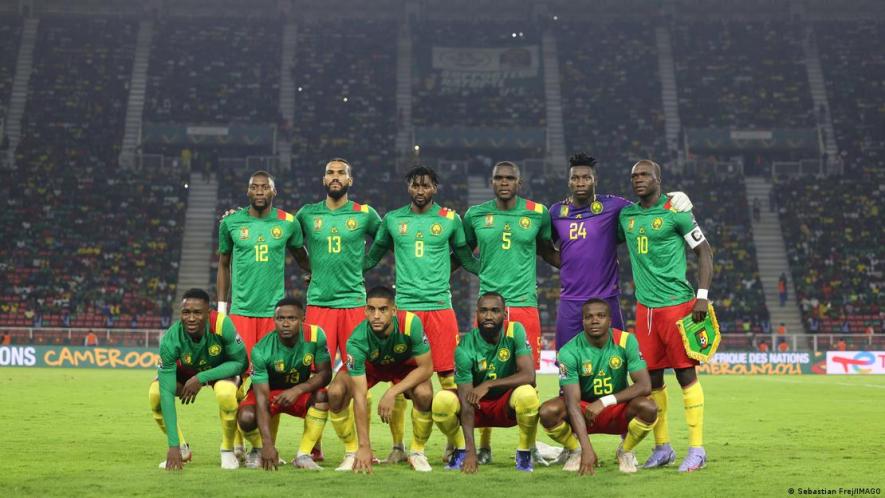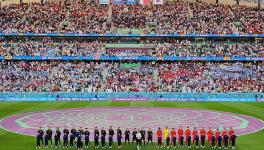World Cup Squads Betray Divide Between Haves And Have-Nots

If you have ever watched your World Cup heroes play for a club on home soil, you can consider yourself lucky. This means you are probably English, maybe Brazilian, but almost certainly not Senegalese.
If you examine the 2022 World Cup squads, you'll find that the average England player has spent 95% of his career in domestic leagues, according to data published by Transfermarkt.com and analyzed by DW. Similarly high numbers are seen in the national squads from European countries with strong league systems, such as Germany and Spain.
The opposite is usually the case with less wealthy clubs and competitions. Among the South American squads at the World Cup — Argentina, Brazil, Ecuador, and Uruguay — the average player has spent nearly half of his career at a foreign side. For the African squads, Senegal, Ghana, Morocco, and Cameroon, the figure is over 80%.
According to the researchers on domestic football leagues interviewed by DW for this story, these numbers are indicative of an unequal dynamic in international football; major European leagues have the financial clout to hold on to their own young talents while at the same time import upcoming stars from developing markets.
Meanwhile, countries with less affluent national setups are often trapped in a vicious circle, which not only prevents them from holding on to their best players, but also keeps them from developing their infrastructure to the point at which it would become less attractive for young players to leave.
Infrastructure lacking in African football
Senegal, the current AFCON title holders, are arguably the continent's best hope of making an impact in Qatar. However, Senegal are also the World Cup team whose players (on average) have spent the least time playing in their home country's leagues.
Nearly half of the players in Senegal's squad have never played for a domestic team from the age of 16 onwards. Those who have played for a local side didn't do so for long, with most moving abroad by their 20th birthday.
Senegal may be the most extreme example, but a similar trend can be observed when examining the other four African squads at the World Cup.
Gerad Akindes, a professor at Qatar's Hamad Bin Khalifa University, who specializes in sports management, says this is due to a combination of factors that started to emerge in the 1980s. That's when African nations started doing better in international tournaments, their young starts started drawing increased attention abroad.
"This was around the time when African football started struggling due to funding cuts to social adjustment programs. Clubs were losing the ability to sustains themselves”, he says.
"And what came onto the scene were football academies. Academies would pop up everywhere, try to recruit kids and send them to Europe. And the consequence of that is the quality of local football dropping."
Even Sadio Mane, the Senegalese star and current African Footballer of the Year, went through such an academy, spending his early years at the Dakar-based Generation Foot, a subsidiary of French second-division club FC Metz. When he was 19, he left the country to sign for the Metz before moving on to Liverpool and later Bayern Munich. An injury ruled him out of this World Cup, but two of his Senegal teammates followed a similar path; Pape Matar Sarr and Ismaïla Sarr, currently ply their trade at English Premier League clubs Tottenham and Watford respectively.
Having large numbers of African players at some of the world's most successful clubs is attractive to television audiences back home. They prefer watching the best footballers their country can produce in Europe's biggest leagues, instead of turning out in person to see them in their weaker domestic leagues. This leaves local stadiums all but empty.
"In the long run, this means that African football is not developing itself anymore. It's like raw materials," says Akindes. "You export it, you make some money, and it comes back with added value for you to consume. It's like exporting oil and then buying rubber afterwards."
In monetary terms, it is the television rights holders in Africa that stand to benefit from this "added value."
This has also led to African national teams relying on more and more of their nationals playing abroad. This phenomenon was exacerbated by a 2004 revision in FIFA eligibility rules that allowed footballers to switch national teams even if they'd represented another country at youth level.
The Ghanaian squad is a good example of this; their final 26-men list includes four late additions of players that had never previously worn the Black Stars jersey. For England-born Tariq Lamptey, Spain-born Inaki Williams, French-born Elisha Owusu, and Belgium-born Denis Odoi the prospect of playing at a World Cup was ample incentive to switch allegiances.

Most Cameroon stars move abroad early in their careers
"What does that say about the players that suffered through the qualifying rounds and now they can't go to Qatar?” asks Wycliffe Njororai, a professor and sports researcher with the University of Texas at Tyler.
"This signals to the local talents that for you to have an opportunity, maybe you must leave the country. It may be easier for you to be selected when you're abroad."
Njororai also points out that such late additions of foreign-raised talent come at a cost, including a lack of chemistry, both on the pitch and off.
"How can you create a cohesive unit to incorporate these players?" he asks. "If they perform well, fans will embrace them. But if they don't, the fallout is massive, and the focus is going to be on the fact that a lot of these players have no connection to the team."
Looming identity crisis in South America
Compared to the Africans, most South American World Cup players stayed at local clubs longer. Only three players from the region didn't play for a local side after turning 16.
Uruguay midfielder Rodrigo Bentacur started his career at Argentine outfit Boca Juniors in Buenos Aires, just 120 kilometers (75 miles) away from his hometown. Ecuador's, Jeremy Sarmiento joined the senior national team after representing England in his youth years. And, of course, there's Lionel Messi, the seven-time Ballon d'Or winner who left Argentina at the age of 13 to join Barcelona.
However, even if it's still not subject to as intense, early predatory scouting, South American football is exposed to similar economic pressures as the African game. The continent's leagues may be stronger and hold on to young talents for a little longer, but it isn't by much; the average South American player at this World Cup first moved abroad at the age of 21.
As in Africa, this dynamic also affects the relationship between fans and local clubs – even in Brazil, the only country to have won five World Cups and home to clubs that just a decade ago prided themselves on being able to compete with some of Europe's best sides.
According to Rodrigo Koch, a professor at Rio Grande do Sul State University who studies the relationship between football and youth culture in Brazil, young Brazilians no longer have the same connection to local clubs as their parents and older relatives do. This is especially significant in a country in which club allegiances tend to pass from father to son are staples of regional identity.
"I wouldn't call those young people club supporters. They became football aficionados and celebrity followers", says Koch, explaining that they are no longer loyal to one specific club, but instead choose to follow the teams that feature their favorite players – Neymar's Paris Saint Germain is currently among the most popular.
"Maybe it won't happen as quickly as in Africa, but we are in the middle of this transformation," he adds.
"We still have hardcore supporters of local clubs, we still have grassroots fans, we still have those who follow a family tradition... But we have more and more of this kind of fan who embraces a more cosmopolitan identity, so to speak."
Traditionally, when playing football in school or in the streets, Brazilian kids would divide themselves in teams made up of supporters of local clubs, mimicking the Brazilian Championship matches they watched on TV and in the stadium. It could well be that 10 years from now, they'll be dividing themselves between supporters of Vinicius Junior's Real Madrid and Neymar's PSG – or whichever teams the stars of the day happen to play for.
Edited by Chuck Penfold.
Get the latest reports & analysis with people's perspective on Protests, movements & deep analytical videos, discussions of the current affairs in your Telegram app. Subscribe to NewsClick's Telegram channel & get Real-Time updates on stories, as they get published on our website.
























